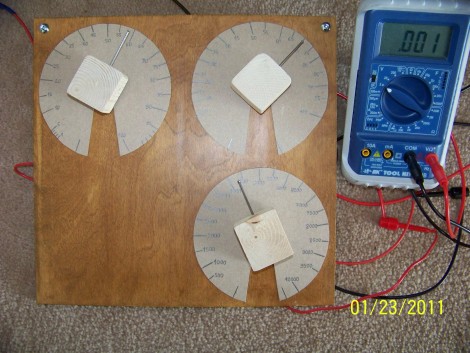
This analog computer can multiply, divide, square numbers, and find square roots. It has a maximum result of ten billion with an average precision of 2-3%. [Miroslav’s] build recreates something he saw in a Popular Electronics magazine. It uses a resistor network made up of three potentiometers with a digital multimeter is an integral part of the machine. To multiply a number you set the needles on the first two knobs to the numbers on which you are operating. To find the result turn the third knob until the multimeter has been zeroed out and read the value that knob is pointing to. It seems much more simple than some of the discrete logic computers we’ve seen, yet it’s just as interesting.















finally the end to confusing digital calculators!
wait … what? O_o
analog computer, very cool!
You see. That’s what i like. Budget techy stuff. This is a cool calculator you’ve posted.
Great find man.
I had seen similar plans when I was younger but could never find them once I got old enough to respect the concept of analog computers. Building one of these with some nice dials and analog meter would make a nice desk conversation piece.
This is awesome. Not only is it an analog computer, but it uses only passive components! Most analog computers do their math with op amps. (like the Heathkit EC-1 from the ’60s)
Challenge: using only the circuit diagram, figure out how it works!
Instead of using multimeter why not use lights. Simple circuit that senses low voltage and turns a diode (or two, indicating which direction to turn the third knob) on and off.
If its an analogue computer shouldn’t it use an analogue metre?
Everybody do the electric slide [rule].
My dad helped me build one of these with an analog meter and hand lettered scales for a grade school science fair project (late 60’s). I don’t remember where the schematic came from. I think it was a book that had like 100 science fair ideas in it. I remember going to a local electronics store to get the right type and resistance potentiometers.
Now it needs an Arduino and some servos to automate the process of moving the knobs. ;)
Ten turn pots with counter dials and a big turn of the last century meter, would take it over the top. Brass, walnut, and ebonite. True steampunk! Two or three figure accuracy could be had. This tech 100+ years ago aimed the big guns on dreadnaughts.
Does anyone know where to find scans of old copies of Popular Electronics like the one referenced in this article? I’m interested in recreating old projects like this one.
I think people tend to forget about these things. For a lot of math computations, you can’t beat the speed of analog systems.
But you always introduce input and output error.
This is a nice way to introduce somebody to math systems.
Would it be difficult to add a button underneath each dial that turns it toward the equilibrium position for you?